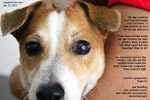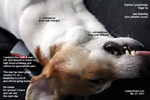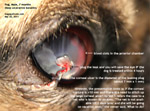One look from my reception counter and I could see that this Jack Russell was suffering from Canine Lymphosarcoma. Some vets prefer to call it Canine Lymphoma. The two lumps of the size of ping-pong balls on the right and left lower jaws were too obvious to miss.
The owners were a young couple in their early 30s and an older woman and there was great emotions involved. The mum was distressed that the 8-year-old male Jack Russell walked into chairs and just could not see on this fine Sunday morning. Only the day before, the dog was zipping here and there when exercised outdoors. No accidents. No falls. No injuries. The dog just couldn't see! Why? What happened?
I decided to handle this case as the leading vet responsible for the outcome and together with my associate vet. Working as a team is a pleasure of veterinary medicine as we share our workload. I asked if she objected as she was on duty, but this was not her client. My associate said: "I am OK."
HISTORY
"What did Vet 1 say?" I asked when the owner showed me the report of a pre-scapular lymph node biopsy sent to the AVA lab.
"Vet 1 said that the AVA lab cannot confirm that the dog is suffering from lymphoma."
I read the report. It stated that it needed at least 2 biopsies from 2 lymph nodes and to relate to clinical signs. The presented biopsy cells could not confirm lymphoma.
So the owners must have concluded that the dog was not suffering from lymphoma!
No further treatment.
EYES
Blood inside both eyes preventing vision.
Note: In canine lymphoma, eye involved in 25% of cases). This can lead to bleeding within the eye, uveitis, glaucoma, retinal detachment and blindness.)
BLOOD TEST RESULTS OF DOG WITH LYMPHOMA OVER AT LEAST 1 MONTH
I was checking for infection (high WCC) or immune suppression (low WCC and platelets) or cancer (e.g. leukaemia with very high WCC), liver and kidney disorder.
Results are as follows:
Haemoglobin 13.9 (12-18)
Total WCC 11.8 (6-17)
Neutrophils 70.51 Abs 8.32
Lymphocytes 16.44 Abs 1.94
Monocytes 11.19 Abs 1.32
Eosinophils 0.09 Abs 0.01
Basophils 1.95 Abs 0.23
Red cell count 5.5 (5.5-8.5)
PCV 0.38 (0.37-0.55)
MCV 69 (60-77)
MCH 25 (20-25)
MCHC 36 (32-36)
RDW 14.1%
Platelets 90* (200-500). No platelet clumps seen.
LIVER PROFILE
ALT/SGPT 169 (<59)
AST/SGOT 138 (<81)
BONE/JOINT FUNCTION
Calcium 2.58 (1.5 -3.6)
Uric Acid 0.05 (<0.13)
KIDNEY PROFILE
Urea 8.3 (4.2 - 6.3)
Creatinine 54 (89-177)
WHAT STAGE OF LYMPHOMA IS THE DOG IN?
I palpated the abdomen. There was mild anterior abdominal pain as the dog hunched but did not bite me. The liver and spleen were enlarged.
The dog was eating and active.
This is now Stage 4a (generalised lymph node involvement with liver or spleen involvement). It is developing into Stage 5a (Stage 4a with blood or bone marrow involvement - see low platelet counts in blood test but no anaemia or low white blood cells yet).
Central nervous system involvement (bleeding in two eyes) but no seizures
Guideline. Stage 5a means the dog is eating normally. Stage 5b means the dog is not eating.
WHAT THE OWNER ASKED ME
1. How long will the dog live without chemotherapy treatment?
I said
it would depend on which stage and infections. 2 months had been
quoted in some reports.
2. How long will the dog live with chemotherapy? It depends on the
disease and drugs. Remission (no enlarged lymph nodes) may be
present for several months, prolonging the life of the dog.
3. Is there a permanent cure?
No.
4. What's the cost?
Varies with the type of treatment. Cost of blood monitoring.
WHAT HAPPENED ON SUNDAY?
There were free blood inside both eyes. The sclera were very red and
from my experience the dog had rubbed his eyes vigorously due to
pain in the abdomen. (From my cases of acute pancreatitis and
reading other vet reports, the dog rubs his eyes to relieve his
intense abdominal pain) causing bleeding.
HOW DID I SOLVE THIS PROBLEM OF BLEEDING EYES AFFECTING VISION?
7 kg. BW. Domitor 0.1 ml, Ketamine 0.2 ml in one syringe IV. Dog
stopped pacing and slept. Eye sclera became normal white (the owners
could see this and were quite impressed). It is highly risky to give
sedation in this situation. Give the lowest dose.
Next day, the owner said the dog could see. The owner has to decide
on whether to do chemotherapy.
 TOA
PAYOH VETS
TOA
PAYOH VETS



